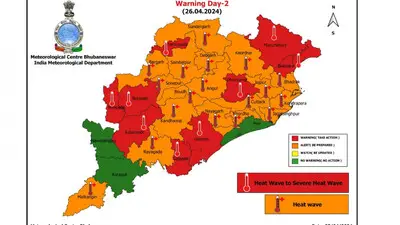Recommended Stories
Shortage of drinking water and an adverse impact on the prices of fruits, vegetables, pulses, sugar has been felt in several areas. Livestock has been hit due to fodder shortage.
Inputs gathered by PTI bureaux across the country suggest that Punjab, Haryana, Rajasthan, Uttar Pradesh, Gujarat, Maharashtra, Karnataka, Bihar, Odisha and Jharkhand have been hit by deficit rainfall.
Sowing of pulses and coarse cereals (like maize, jowar and bajra) has been affected the most. Although paddy area is also down by 18 lakh hectares so far, there is still hope that shortfall will be made up as paddy season extends till August.
While the all-India average of rainfall deficiency is 21 per cent, Saurashtra and Kutch regions in Gujarat are short by 78 per cent, followed by Haryana, Chandigarh and Delhi by 71 per cent and Punjab 67 per cent, according to weather office data up to July 27.
Western Rajasthan has received 64 per cent less rainfall in the season. Different regions in Karnataka have seen rain deficiency between 21 per cent to 44 per cent with the maximum impact felt in South interior parts of the state.
A worried Union Agriculture Minister Sharad Pawar has called a meeting of Empowered Group of Ministers (EGom) here on Tuesday to deal with the situation, while states are working on their own contingency plans.
The government has conceded that production in 2012-13 would be lower than the last year`s record output. "It is certainly not possible to achieve 257.44 million tonnes of foodgrains production this year. It is too early to say how much would be the actual fall in output," Agriculture Secretary Ashish Bahuguna told PTI last week.
Sowing area of total kharif crops has declined by 10 per cent so far at 66.82 million hectare. Coarse cereals is worst affected with 23 per cent shortfall, followed by pulses (18 per cent), paddy (9 per cent) and cotton (7 per cent).
The shortfall in paddy sowing is mainly in Nadia, South 24 Paragana, Murshidabad, Birbhum, Bankura and West Midnapore districts in West Bengal. Of the 18 lakh hectare drop in paddy area across the country, 7 lakh is in West Bengal. Likewise, in pulses and coarse grains, Rajasthan is contributing to the maximum of shortfalls.
Of the 13.64 lakh hectares drop in pulses cultivation, Rajasthan contributes 11.32 lakh hectares. In coarse cereals, the countrywide drop is 34.4 lakh hectares of which the state accounts for nearly 20 lakh hectares.
However, the saving grace is that Punjab and Haryana, considered as "food bowl of the country", have managed to cope with the situation by using the ground water. Their acreage of paddy are almost at last year`s level.
As farmers are investing more on diesel and power to irrigate their land, the measures which may be considered by the EGoM include giving diesel subsidy to farmers. "Diesel subsidy was introduced in 2009 in Bihar and Tamil Nadu. It was continued in 2010. It can be put up...it could be an issue in the EGoM," Bahuguna said.
The country had faced severe drought in 2009 which caused foodgrain production loss of 16 million tonnes to 218 MT.
Banks too are a worried lot. They fear drought would have impact the loan repayments of the farm credit, which was 4.76 lakh crore in 2011-12. "If the Monsoon fails, it will have a cascading impact on credit growth as well as the economy, which in turn, will impact the repaying capacity of borrowers," State Bank of India Chairman Pratip Chaudhuri said.
The industry too is tensed as the rural demand will be hit. The leading business chambers, CII and Assocham, have asked for immediate government intervention to mitigate the impact.
Reports emanating from states reveal that the situation is bad due to weak monsoon which is affecting agriculture as well as fodder availability.
Karnataka:
As per assessment of the state government, 22 districts out of a total of 30 have been badly affected due to deficient rain. Sugarcane, paddy and maize crops have been hit hard, state Agriculture Minister U Katti told PTI.
"The state has only 11 weeks of fodder stocks left with it and is talking to Punjab for additional supply," he said.
"The state has demanded a package of Rs 5,800 crore from the Centre for crop loss due to poor monsoon," he added.
Maharashtra:
Maharashtra, which has received on an average 79 per cent rainfall is facing shrinkage of area under sowing almost by half. "The kharif sowing season is coming to an end and 102 talukas have less than 50 per cent sowing," Chief Minister Prithviraj Chavan has said.
A contingency plan of Rs 2,685 crore has been readied to tackle the situation, he said. "If rains fall in August, first phase of the contingency plan is ready," Chavan said, adding that if necessary the state will approach the Centre for more funds.
Rajasthan:
The desert state of Rajasthan is facing a deficit rainfall of nearly 36 per cent due to which sowing of kharif crops have shrunk by almost half against the target for this year. The government had fixed a target to sow kharif crops in 150 lakh hectare this year, of which plantation has been done only in 77 lakh hectare.
Faced with the grim situation, Chief Minister Ashok Gehlot has written a letter to the Centre requesting to increase the days of employment for workers under MGNREGA to 200 from 100 at present during crisis period like the one prevailing now due to poor monsoon.
Gujarat:
The area under kharif crops has dropped 24 per cent so far in Gujarat compared with the year-ago period with the state receiving 65 per cent less rainfall this year.
"The total sowing under kharif this season has reached 45.55 lakh hectares so far compared to 60 lakh hectares a year ago," an agricultural department official said.
According to an Indian Meteorological Department official, there is 65 per cent deficient rainfall so far in the state, with Saurashtra and Kutch regions reporting 77 per cent deficit.
The Saurashtra and Kutch regions account for nearly 70 per cent of the total cotton production in the state, and is also a major agri production belt. Apart from cotton, groundnut and castor seed are major crops.
Punjab and Haryana:
A report from Punjab and Haryana said the situation in the two states is aggravated due to power shortage. The state government has sought additional fund from the Centre to meet the expense they are incurring.
In Punjab and Haryana, the area under paddy, a principal crop in the kharif season, has nearly reached the target due to irrigation facility.
Paddy sowing in Punjab is almost on the verge of completion with 98 per cent of the targetted area being covered. Against the target of sowing paddy in 27.8 lakh hectares, the state has completed the exercise in 27.34 lakh hectare.
In Haryana, area under paddy has touched 9.87 lakh hectare, against a target of 12 lakh hectare.
But, Punjab expects fall in area under crops like cotton, maize and oilseeds. Haryana is foreseeing a drop in land under bajra and cotton.
Farmers are spending an extra sum of money varying from Rs 1,500 to Rs 2,000 per hectare on paddy crop for irrigation.












